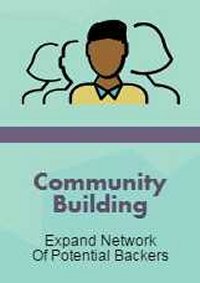Community building involves all the activities to bring awareness to your upcoming crowdfunding campaign. Your campaign blog is part of this step. These steps are conducted simultaneously. When combined, they are the most time-consuming portion of the entire crowdfunding campaign. In most cases, these steps will take you about 9 weeks or so to do effectively.
Community Building with Influencer
Send the influencers on your list an email and asked them for advice about your upcoming crowdfunding campaign. Be sure to mention that you read their post/article/book. If you mention that you enjoyed reading it, you will increase the likelihood they will reply to your request. Prioritize your list of influencers and focus on sites and people that are the most active. Read and share information in your topic area to build trust with influencers before asking them to support your campaign.
Even if you do all the right things, expect about a 10% return rate on your cold contacts. However, with a few good social shares, some campaigns have been able to boost their return rates to 15-20%. Start sending out emails to your list as you countdown to the launch to build momentum.
Pre-Launch Backer Support
Now is the time to try to get committed backer support prior to your launch date. With potential backers is may be necessary, make their pledge contingent on reaching a specific funding level. For example, you might say,
“Can I count on you to support us at the platinum level if we raise 20% percent of our goal?”
If they are not receptive, ask,
“How about supporting us at the gold level?”
If necessary, go all the way and ask,
“Will you at least support us at the $10 High-Five level?”
If you don’t ask, most people will not pledge because this is the point in the campaign where you begin to ask for their pledges. Based on successful campaigns, your goal should be to get at least 20% of your target amount in pre-launch pledges from your network.
Launch Party
Another effective way to build a community is to have a launch party. The best days to host a launch party are Mondays and Tuesdays. Be sure that the place that you choose for your launch party has internet access. Also, make sure you have a microphone and speaker system to speak to the crowd as well as a projector and computer to display videos and pictures of your product.
The best launch parties build enthusiasm for the campaign and have a creative twist to make them memorable. Perhaps you can buy a canvas and some paint from an art supply company and encourage everyone at the launch party to contribute to a painting. Later you can post the painting on the campaign blog and give it away as a reward after the campaign.
Consider offering several special rewards during your launch party as well. Consider a reward for the first backer, largest pledge, and random drawings to keep the energy level high. This is a great opportunity to get some great footage and images for your blog. Don’t be afraid to be creative and don’t forget to ask for pledges at the launch party.
Committed vs Ideal Backers
Your list of committed backers is different from the ideal backer since your committed backers at this point likely include family and friends.
Drew Johnson, a colleague of mine that ran a successful reward-based crowdfunding campaign for TechWears shared the following advice. If he had it all to go over again, he would have scrubbed his look-a-like list when he used a Facebook ad campaign to find backers.
Drew had collected a list of about 500 people who signed up at his various demos and craft fairs where he demonstrated and sold his unique TechWears products. His initial thinking was that since the 500 on his list stopped by his booth, engaged with him in a discussion about this product, and were willing to sign-up for his mailing list that they were all potential backers. Unfortunately, many on the list were “tire kickers” who signed his list more out of politeness rather than genuine interest.
When he used his list in a Facebook look-a-like ad campaign, the demographic he targeted was not the audience that was actually looking to buy geek-wear as he calls it. In the end, it cost him more money and did not get him the conversion rate he was hoping for from the ad campaign.
Therefore, if you plan to use a Facebook ad campaign and use look-a-like list, you should scrub your list to remove those people not likely to be your ideal backer.
What are your plans for building a community for your next campaign?












